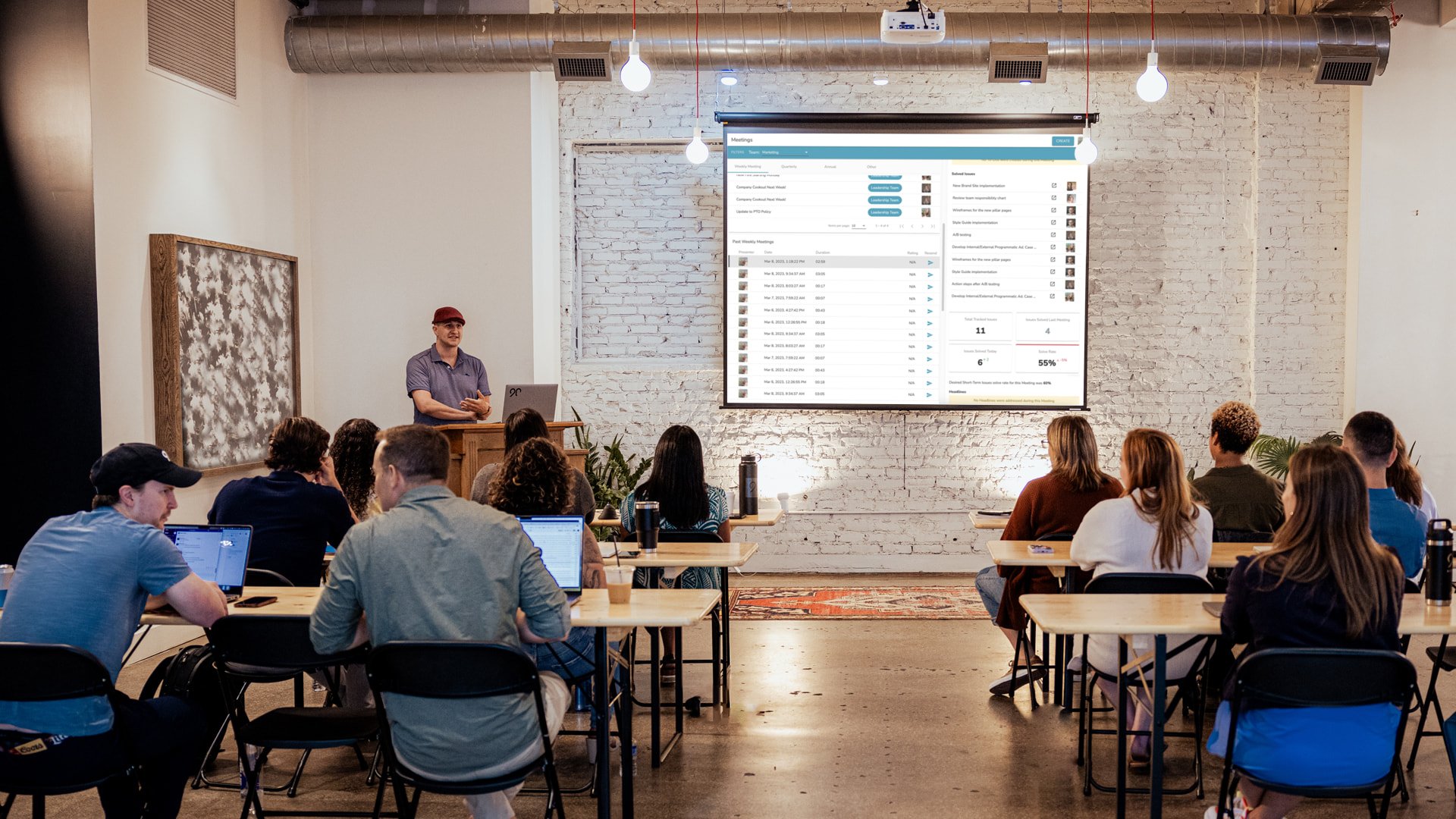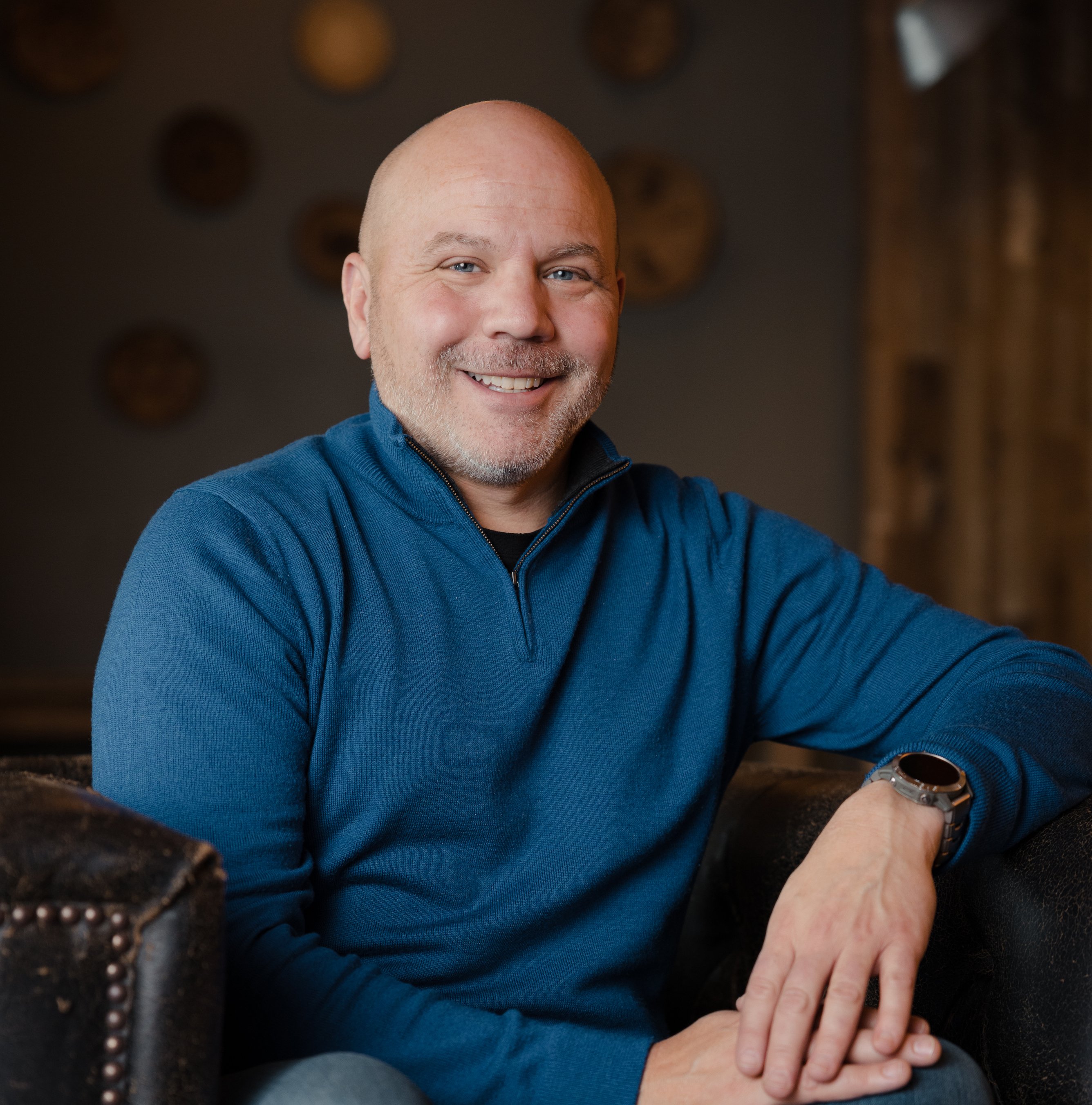The EOS® Quarterly Meeting: How to Operate in a 90-Day World®
Last week, I facilitated a quarterly with one of my favorite clients. I know — we’re not supposed to have favorites, but… This company is crushing its sales and operating goals: 30%+ year-over-year growth and increasing its enterprise value every quarter. However, they’re behind on Rock performance and are not on track for their annual goals. They rated their quarter a Learn. This level of discipline and vulnerability of leaders inspires me in the quarterly meeting process.
The combination of our lagging indicators (revenue and profit), our leading indicators (measurables), and Rock performance brings us to an open, honest, and vulnerable conclusion on how we did last quarter.
In today's fast-paced business environment, staying focused and aligned on your company's goals is crucial for success. The Entrepreneurial Operating System® (EOS) is a proven framework that helps businesses achieve their vision by operating in a 90-Day World, where teams set and review priorities every quarter. Clearly, I agree with Gino Wickman when he says in his book Traction©, “90 days is about as long as a human being can stay focused. It’s human nature, so stop fighting it and solve the problem by following the Quarterly Meeting Pulse.”
In this article, I’ll explore how the EOS quarterly meeting can progress and ensure continuous improvement for your organization. You’ll learn about the benefits of operating in a 90-Day World, such as increased focus and productivity, clearer goal setting and prioritization, and enhanced team alignment and collaboration. I’ll also touch on how to do this in a “Shared by All” and “Followed by All” method powered by Ninety.
And I’ll provide practical tips on preparing for and conducting successful quarterly meetings, aligning company and department goals, and maximizing the impact of these meetings on your organization's growth.
So, let's dive in and discover how you can ignite progress every 90 days with EOS quarterly meetings.
Key Points:
- The EOS quarterly meeting and 90-Day World maintain your organization’s Traction®
- Committing to the EOS Meeting Pulse empowers leaders to work “on” the business
- Reviewing the previous quarter provides necessary insights to plan for the future
Brief Overview of EOS — The Entrepreneurial Operating System
EOS is a complete model for operating a small or midsize business effectively. It summarizes the various aspects of modern organizations into Six Key Components™ — People, Data, Vision, Issues, Process, and Traction. Ninety offers EOS software to bring these components together on our integrated platform.
How has EOS sparked growth for over 190,000 companies? The time-tested and proven EOS Model®.
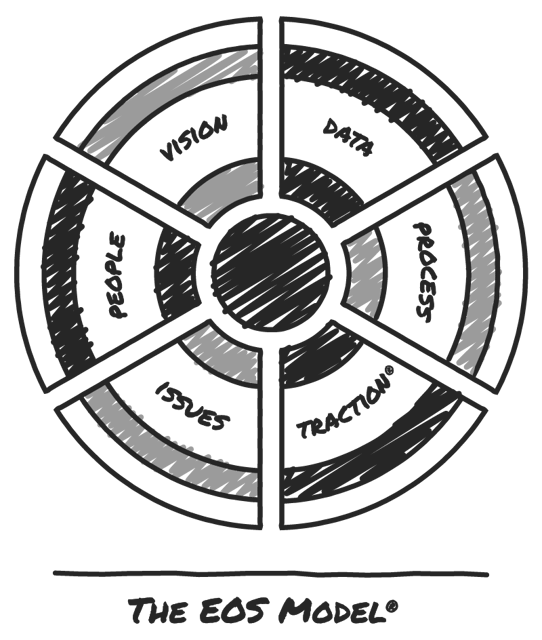
The 90-Day World® of the EOS Process®
The EOS Process brings organizations into a 90-Day World anchored by three quarterly meetings and an annual planning session. This quarterly Meeting Pulse allows your teams to maintain a practice of stepping outside the business's daily operations to review the previous quarter and strategize about the next 90 days.
Quarterly meetings should be full-day sessions, and I strongly recommend that you hold them off-site when possible. You’ll want the whole team’s full attention while diving into your V/TO®, Rocks, and Long-Term Issues.
Once per year, we switch the pulse to a 2-day annual planning session. The first day covers team health and long-term strategy. And the second day primarily focuses on 3-year, 1-year, and 90-day goals before moving to clear the Issues List.
Dividing your year into four 90-day segments keeps your teams engaged by offering timely feedback, increasing focus, and providing a healthy amount of urgency to your quarterly goals.
As part of the 90-Day World, I’m going to explain how to prepare for a successful quarterly meeting, share a proven agenda, and offer tips to generate the most value out of your next quarterly.
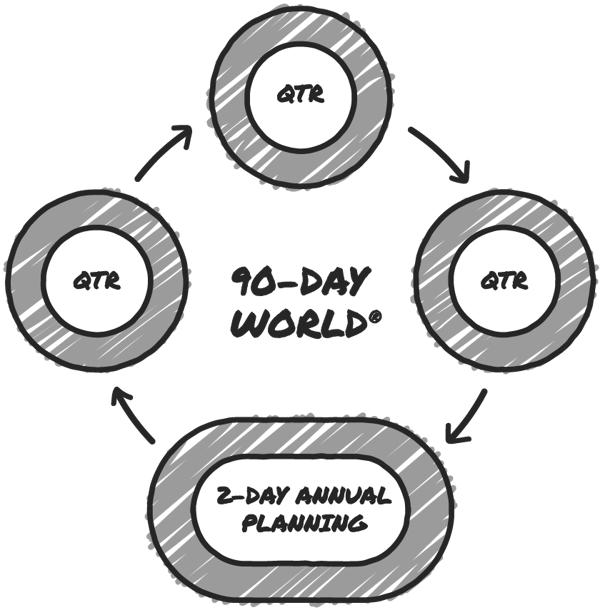
Preparing for a Successful EOS Quarterly Meeting
If your team has never taken the Organizational Checkup™ from EOS, or it’s been a while since you have, I recommend starting there while preparing for your quarterly. This quick assessment will give you an idea of how strong your team sees your company through the lens of the Six Key Components.
Have your team members prepare for the meeting by giving them a To-Do to assess your team’s Issues Lists as well as their Rocks, To-Dos, and Measurables.
One of the main goals of quarterly meetings is to find alignment with your team. Over the course of 90 days, it’s natural for priorities to lose clarity, so it’s critical to maintain a quarterly meeting cadence.
The EOS Quarterly Meeting Agenda
EOS companies follow this simple quarterly meeting agenda:
- Segue. 15 minutes. Focus on connection by sharing personal and professional bests from the last 90 days. Then, have everyone share what they believe to be working and not working on their team or in the organization as a whole. Finally, everyone should state their expectations for the meeting. At Ninety, we believe in agreements-based leadership; you have expectations, and we must agree before proceeding.
- Review Previous Quarter. 30 minutes. Take this time to review all your numbers (quarterly revenue, profit, gross margin, and any other relevant key numbers) and your Rocks. For alignment's sake, I ask clients to decide if the quarter is a “Win” or “Learn” for the team. I believe we’re playing an infinite game, and we should decide each quarter if we Won by meeting our goals or Learned such that we can celebrate the Win or share in our Learning. For any incomplete Rocks, consider creating To-Dos to carry the Rock to the next quarter or assigning it to someone else.
- Review the V/TO. 60 minutes. The singular intent of this is to refresh our active memory of our vision and make sure we’re still on the same page. I’ve often found that teams like elements of the Vision/Traction Organizer® in principle or as an artifact that represents something of their history, but if it’s not part of your present culture or goals, it can represent an Issue to discuss. This is an excellent opportunity to update the sections of your V/TO. At least ensure to read through it and answer any questions. If this is a department-level meeting, you may have your own V/TO to review with your team.
- EOS Tools. 60 minutes. While not stated in the book Traction, EOS Implementers coach a new tool or refine one every quarter as we pursue mastery and being 80% Strong across the Six Key Components. We view the toolbox and decide what is the most relevant and helpful for the next quarter.
- Establish the Next Quarter’s Rocks. 120 minutes. List all the major initiatives and priorities for the quarter or simply everything that must be done next quarter. Proceed to simplify the list until you have about 3–7 Rocks, then assign someone accountable for each. Ninety's Rocks tool gives the whole team visibility on Rock progress.
- Solve Key Issues. 180 minutes. First, make sure all the Issues are on your list. Then, it’s time to bring your IDS® skills from The Issues Solving Track™ to a new level. Identify, Discuss, and Solve the Issues on your Long-Term Issues List located on your V/TO and Ninety’s Issues tool.
- Next Steps. 7 minutes. Clarify everyone’s next action step. Identify who is accountable for the assigned To-Dos and decide what messages you want cascaded to other teams.
- Conclude. 8 minutes. To cap off an amazing day of productivity and alignment, have everyone share their feedback from the meeting, share if their expectations were met, and rate the meeting on a scale of 1–10. Keep in mind that 10 is not about perfection, it’s about performance. Start at 10 and work backward. We want the standard to be above 8.
Tips for Maximizing the Impact of EOS Quarterly Meetings
One of the best ways to maximize your next quarterly meeting is to move it off-site. Quarterlies involve working on the business, so going off-site helps change everyone’s mindset from day-to-day responsibilities. If your team works remotely, I highly recommend meeting in person at least once a year for a quarterly or annual meeting.
“The quarterly meeting brings peace of mind to a founder as the organization gains Traction 90 days at a time.”
— Mike Schroeder, Founder and President of Roundstone Insurance
I can’t express too often how important developing a high-trust culture is for having the transparency and honesty needed to call out the Issues and opportunities for your team.
After the meeting, make a To-Do for everyone to make their Rocks SMART. Additionally, the leadership team should schedule and plan a quarterly State of the Company Meeting to share their quarterly’s results, communicate their Vision, update priorities and Rocks, and more.
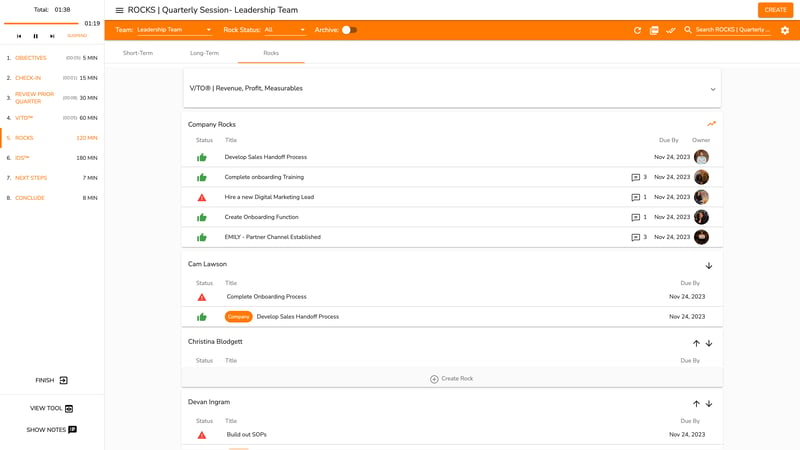
Quarterly Meetings Are a Forever Work — Ninety Powers Your 10-Year Target™ Success
Quarterly meetings are the four cornerstones of any team’s or organization’s source of alignment and productivity. Use them to reflect on the previous 90 days and prepare to launch into the next with clarity, purpose, and drive. If your organization runs on Ninety, your implementer or coach can view your Rocks and Scorecard before the meeting, so they’ll be up to date and ready to facilitate your quarterly.
Powering your EOS journey with Ninety simplifies the hard work of building a great company. Use our Meetings tool to customize the agenda to fit your needs, record notes, and pull up your information in real-time during your next quarterly.
The Meetings tool will track the time to keep you on schedule, allow you to easily document To-Dos, and provide a shared space for completing your quarterly meeting whether you’re meeting in person or remotely.
Don't let another quarter go by without the focus and alignment your team needs to execute. Experience the power of Ninety's purpose-built software for quarterly meetings.
Receive EOS® best practices, tips, and insights every week.
Frequently Asked Questions
What is EOS, and how does it relate to quarterly meetings?
EOS is a set of concepts and tools for operating a small or midsize business. This operating system focuses teams on running in a 90-Day World based around productive quarterly meetings.
How can organizations benefit from holding quarterly meetings?
Organizations benefit from quarterly meetings by obtaining alignment on goals, priorities, and vision. An essential step of each quarterly is reflection on the previous 90 days.
How can I align EOS quarterly meeting priorities with company goals?
Your EOS quarterly meeting priorities should align with your company goals. Your V/TO should document your longest-term goals so you can always focus on connecting your quarterly Rocks to these goals.
What is the agenda for an EOS quarterly meeting?
An EOS quarterly meeting’s agenda flows like this:
- Segue
- Review previous quarter
- Review the V/TO
- EOS Tools
- Establish new Rocks
- Solve Key Issues
- Next Steps
- Conclude
Read more about this agenda above.
How do you prepare for the EOS quarterly meeting?
You can prepare for your quarterly meeting by keeping your Rocks, To-Dos, and Long-Term Issues List current. Read blogs like this to understand EOS better and chat with your team leader to manage expectations.
What do you talk about in a quarterly meeting?
Discussions in quarterly meetings cover the previous and future 90-day goals, key Measurables, and Issues. Teams also focus on thinking through their connection to the organization’s vision and how their goals tie into the greater objectives of the company.
How can I adapt EOS quarterly meetings to remote or virtual settings?
Remote teams can benefit from EOS quarterly meetings by powering their experience with Ninety, using an implementer as their facilitator, and considering meeting in person. You’ll use the same agenda and focus on the same priorities, whether remotely or in person.
